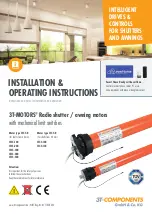
Illustration 19
g01223241
A typical example of the layout of the valves of a
three cylinder engine
(A) Exhaust valves
(B) Inlet valves
Table 1
1103AA Constant Speed Specifications
Number of Cylinders
3 In-Line
Bore
105 mm (4.134 inch)
Stroke
127 mm (5.0 inch)
Aspiration
Naturally aspirated
Turbocharged
Compression Ratio
NA 19.25:1
T 17.25:1
Displacement
3.3 L (201 in
3
)
Firing Order
1 2 3
Rotation (flywheel end)
Counterclockwise
Valve Lash Setting (Inlet)
0.20 mm (0.008 inch)
Valve Lash Setting (Exhaust)
0.45 mm (0.018 inch)
Table 2
1104AA Constant Speed Specifications
Number of Cylinders
4 In-Line
Bore
105 mm (4.134 inch)
Stroke
127 mm (5.0 inch)
Aspiration
Turbocharged
Turbocharged aftercooled
Compression Ratios
T 18.2:1, TA 18.2:1
Displacement
4.4 L (268 in
3
)
Firing Order
1 3 4 2
Rotation (flywheel end)
Counterclockwise
(continued)
(Table 2, contd)
Valve Lash Setting (Inlet)
0.20 mm (0.008 inch)
Valve Lash Setting (Exhaust)
0.45 mm (0.018 inch)
Engine Cooling and Lubrication
The cooling system consists of the following
components:
• Gear-driven centrifugal water pump
• Water temperature regulator which regulates the
engine coolant temperature
• Gear-driven oil pump (gear type)
• Oil cooler
The engine lubricating oil is supplied by a gear type
pump. The engine lubricating oil is cooled and the
engine lubricating oil is filtered. Bypass valves
provide unrestricted flow of lubrication oil to the
engine parts when oil viscosity is high. Bypass valves
can also provide unrestricted flow of lubrication oil to
the engine parts if the oil cooler should become
plugged or if the oil filter element should become
plugged.
Engine efficiency, efficiency of emission controls, and
engine performance depend on adherence to proper
operation and maintenance recommendations.
Engine performance and efficiency also depend on
the use of recommended fuels, lubrication oils, and
coolants. Refer to the Operation and Maintenance
Manual, “Maintenance Interval Schedule” for more
information on maintenance items.
Engine Service Life
Engine efficiency and maximum utilization of engine
performance depend on the adherence to proper
operation and maintenance recommendations. In
addition, use recommended fuels, coolants, and
lubricants. Use the Operation and Maintenance
Manual as a guide for required engine maintenance.
Expected engine life is generally predicted by the
average power that is demanded. The average
power that is demanded is based on fuel
consumption of the engine over time. Reduced hours
of operation at full throttle and/or operating at
reduced throttle settings result in a lower average
power demand. Reduced hours of operation will
increase the length of operating time before an
engine overhaul is required.
20
M0105633-01
















































